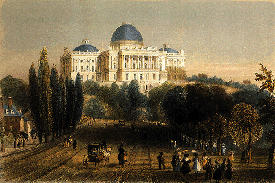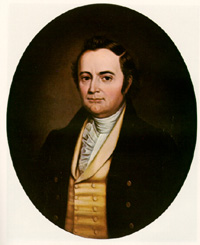
The Nineteenth United States Congress was a meeting of the legislative branch of the United States federal government, consisting of the United States Senate and the United States House of Representatives. It met in Washington, D.C. from March 4, 1825, to March 4, 1827, during the first two years of the administration of U.S. President John Quincy Adams. The apportionment of seats in the House of Representatives was based on the Fourth Census of the United States in 1820. The Senate had a majority of Jackson Men, while the House had an Anti-Jackson (pro-Adams) majority.

Elections to the United States House of Representatives for the 20th Congress were held at various dates in each state in 1826 and 1827 during John Quincy Adams' term in office.

Elections to the United States House of Representatives for the 19th Congress coincided with the contentious presidential election of that year. While the bulk of states held their elections in 1824, six states scheduled their general elections at various times during 1825.
The United States Senate elections of 1808 and 1809 were elections that had the Federalist Party gain one seat in the United States Senate, and which coincided with the 1808 presidential election. The Federalists had gone into the elections with such a small share of Senate seats that even if they had won every election, they would have still remained a minority caucus.
The United States Senate elections of 1876 and 1877 had the Democratic Party gain five seats in the United States Senate, and coincided with Rutherford B. Hayes's narrow election as President. Republicans remained in the majority, however.
The United States Senate elections of 1888 and 1889 were elections that coincided with Benjamin Harrison's victory over incumbent President Grover Cleveland. Both parties were unchanged in the general elections, but later special elections would give Republicans an eight-seat majority, mostly from newly admitted states.
The United States Senate elections of 1840 and 1841 were elections which, corresponding with their Party's success in the 1840 presidential election, had the Whig Party take control of the United States Senate.
The United States Senate elections of 1838 and 1839 were elections which had the Democratic Party lose seven seats in the United States Senate, but still retain a majority.
The United States Senate elections of 1816 and 1817 were elections for the United States Senate that had the Democratic-Republican Party gain a net of two seats from the admission of a new state, and which coincided with the presidential election.
The United States Senate elections of 1820 and 1821 were elections for the United States Senate that, corresponding with James Monroe's landslide re-election, had the Democratic-Republican Party gain seven seats, assuming almost complete control of the Senate.
The United States Senate elections of 1796 and 1797 were elections for the United States Senate which, coinciding with John Adams's election as President, had the ruling Federalist Party gain one seat.
The United States Senate elections of 1792 and 1793 were elections of United States Senators that coincided with President George Washington's unanimous re-election. In these elections, terms were up for the ten senators in class 2.
The United States Senate elections of 1836 and 1837 were elections that had the Jacksonian coalition emerge as the Democratic Party, and the Adams, or Anti-Jackson, coalition emerge as the Whig Party
The United States Senate elections of 1794 and 1795 were elections that had the formation of organized political parties in the United States, with the Federalist Party emerging from the Pro Administration coalition, and the Democratic-Republican Party emerging from the Anti-Administration coalition.
The United States Senate elections of 1834 and 1835 were elections that had the Anti-Jackson coalition maintain control of the United States Senate. However, during the 24th Congress, the Jacksonian coalition gained control of the Senate.
The United States Senate elections of 1832 and 1833 were elections that had the Anti-Jackson coalition assume control of the United States Senate from the Jacksonian coalition, despite Andrew Jackson's victory in the presidential election.
The United States Senate elections of 1830 and 1831 were elections that had Jacksonians gain one seat in the United States Senate from the Anti-Jacksonian coalition, but lose one seat to the short-lived Nullifier Party. By the time Congress first met in December 1831, however, the Jacksonians had a net loss of one seat.
In the United States Senate elections of 1828 and 1829, the Jacksonian coalition, despite its leader's victory in the presidential election, lost a seat in the Senate to the opposing Anti-Jacksonian coalition.
The United States Senate elections of 1826 and 1827 were elections that had the majority Jacksonians gain a seat in the United States Senate.
The United States Senate elections of 1822 and 1823 were elections for the United States Senate that had the Democratic-Republican Party continue almost complete control of the Senate.




